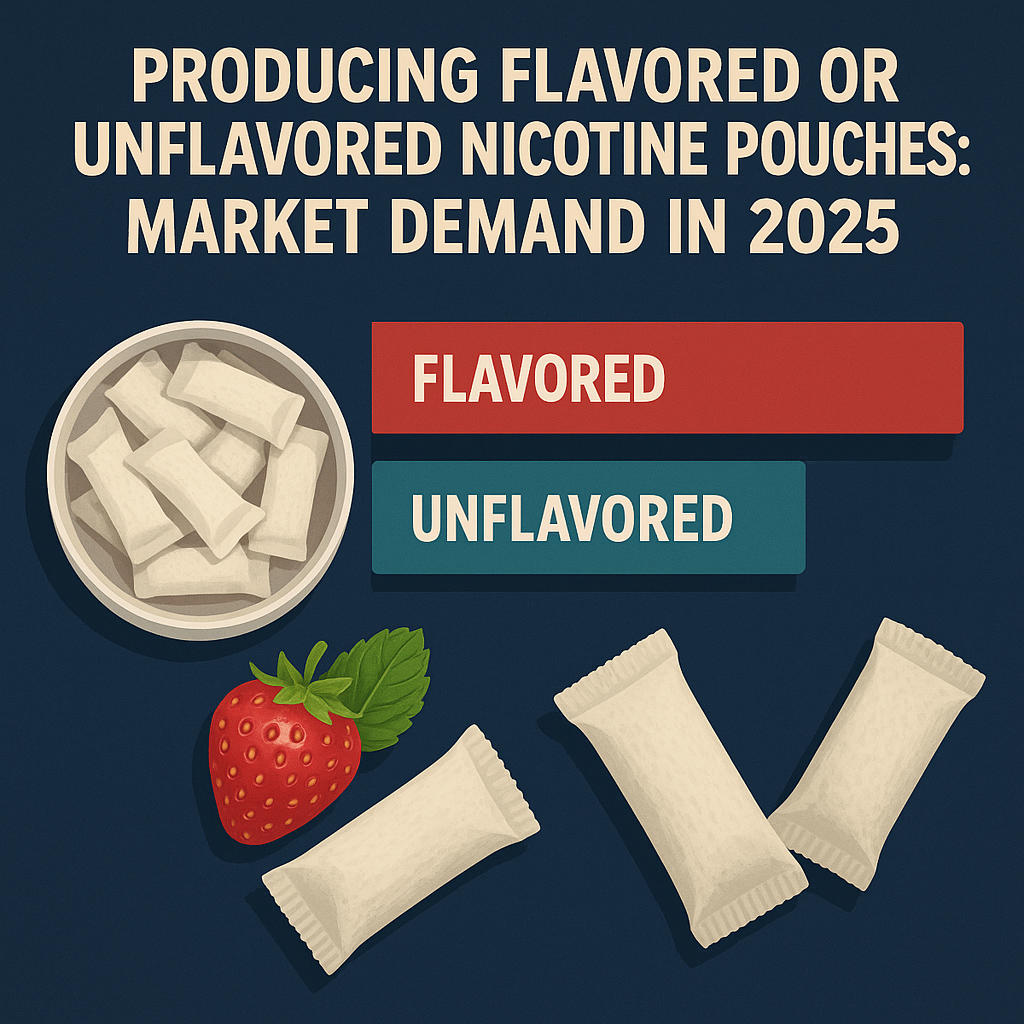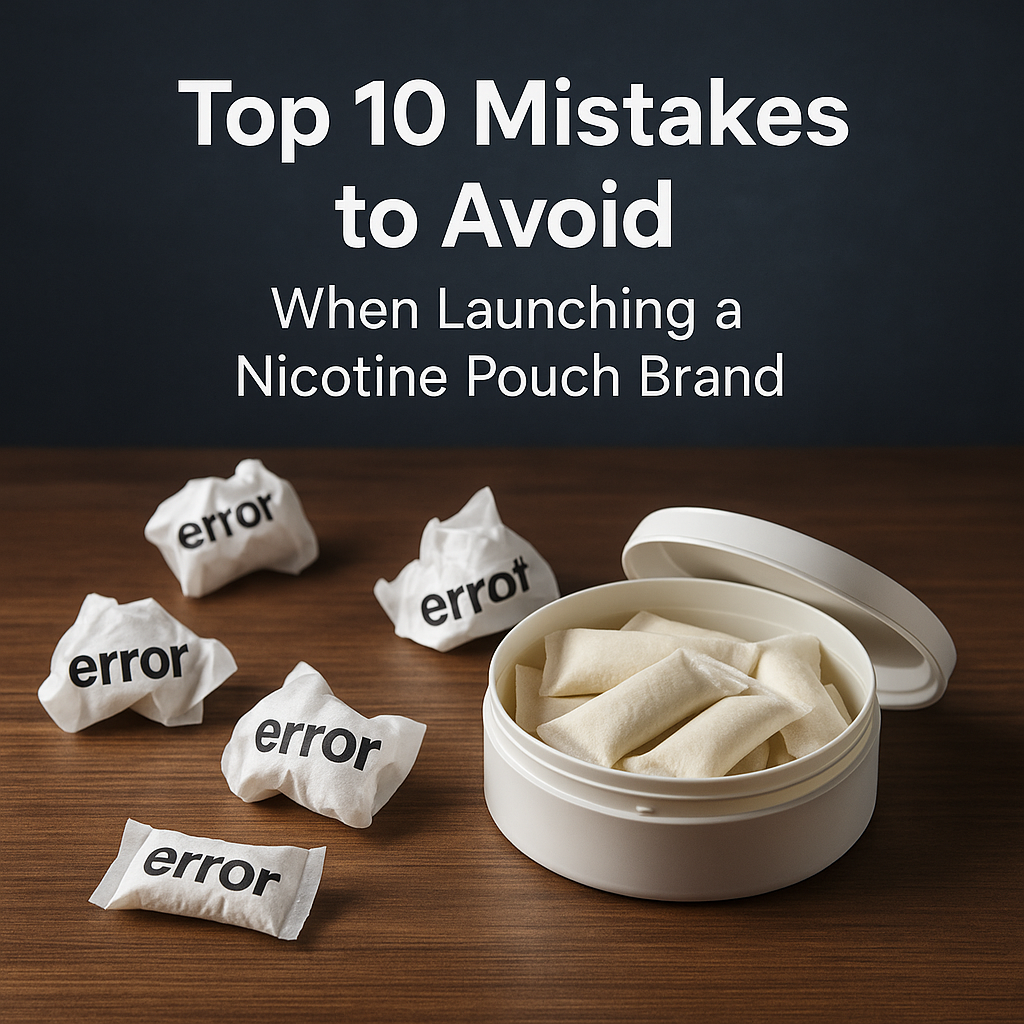So, let’s begin with a simple question. Have you noticed that more and more people are using some small, discreet nicotine pouches? Well, to your amazement you will see more of it in the coming time.
The global nicotine pouch market has witnessed remarkable growth in recent years. Just last year, in 2023, the nicotine pouch market size reached an impressive US$ 2.5 billion. But here’s the interesting part! It is expected to increase even more, with an unprecedented CAGR of 28.53%. As per the data gathered by IMARC Group, in around 10 10-year period, it is projected to reach US$ 23.7 billion in 2032.
What’s fueling this rapid growth? Well, interestingly nowadays, people are seen adopting nicotine pouches as a smoking alternative.
But why are they doing so?
First, They are actively becoming aware of the effects of tobacco consumption.
Secondly, you can now easily get your hands on this product due to its online availability. They’re also discreet and come in various flavors, making them a hit among a broad audience.
Importance of Knowing about the Nicotine Pouch Market
There are various reasons to understand the nicotine pouch market.
For Consumers: It provides various insights about healthier alternatives to traditional tobacco products.
For businesses: It highlights emerging opportunities and explains the competitive landscape in the nicotine pouch industry.
Regulators: It will allow the regulators and public health officers to benefit from understanding the trends and challenges associated with this rapidly growing market.
Purpose of the Article
The purpose of this article is To:
- Present an in-depth analysis of the nicotine pouch market.
- Inform readers about the market’s present situation, popular regions, and major participants.
- Discover the reasons for the growing popularity of nicotine pouches.
- Discuss the future outlook of the industry.
By doing so, it seeks to offer valuable insights to stakeholders across various sectors.
Popularity and Reasons for the Rise in Use of Nicotine Pouches
We have seen that as the days gone by the nicotine pouch market is gaining immense among of traction. So, What’s driving people to switch to nicotine pouches?
Reports indicate that Health is a big factor. People are now becoming more conscious of their health. They are doing their utmost to limit their exposure to harmful substances. Another aspect is the discreetness of nicotine pouches.
Nicotine pouches provide a smokeless, spit-free, and frequently discrete alternative to satisfy their nicotine needs. Everyone else can use them in both public and private settings, with no stigma associated with smoking.
Another significant draw is the variety of flavors. Flavored alternatives are popular among young adults. Furthermore, you may readily purchase the product online. You can get many brands and flavors of tobacco from any online shop that sells tobacco products.
Key Regions/Countries Where Nicotine Pouches Are Popular

So where are these pouches flying off the shelves?
When we look at regions, Europe appears to be the main market. Nicotine pouches are popular in Europe, particularly in Scandinavia. Europe accounted for more than 47.2% of market revenue in 2022. North America contributed around 33.6% share of the global nicotine pouch market. On the other hand, Southeast Asia and the Eastern Mediterranean have a low market share due to the prevalence of cigarette smoking.
Let’s have a look at individual countries now:
United States
First and foremost, the United States currently dominates the market for nicotine pouches. The US was very quick to embrace the nicotine pouches. Swedish Match’s ZYN is leading the market. By 2023, the United States had the biggest share of world consumption. Records show that Americans bought 14.97 billion nicotine pouches in 2023 alone.
Sweden
Sweden is next in line after the United States. Last year, around 2.2 billion units were sold by 2023. It is also the birthplace of nicotine pouches, which developed from the traditional use of snus. In 2022, the Swedish nicotine pouch market was valued at approximately $250 million. Swedish brands like VELO, Swave, and Skruf are some of the leading brands today.
Denmark
Denmark is third on the list, with 745 million units. It is a significant player in both production and consumption. The Danish market saw a 30% increase in sales in 2023.
Finland
Nicotine pouches sales are growing in Finland. In Finland in 2023, as the distribution of nicotine pouches became less controlled, nicotine pouch use appeared to increase. As a result, Finland’s nicotine pouch market increased by 25% in 2023, demonstrating consistent growth.
Poland
Poland has shaken up the Nordic dominance in the nicotine pouch market with brands like 77 pouches. In 2020, 77 was the top brand for nicotine pouches in Poland. By 2023, the market growth rate for nicotine pouches in Poland was 20%. Euromonitor International predicts that by 2025, the market for nicotine pouches in Poland will grow by nearly 97%.
Austria
Austria is one of the emerging markets in the nicotine pouches industry. Like other European nations, is embracing smokeless products as a safer substitute for regular tobacco. It sold 695 million units in 2023.
Pakistan
Pakistan is one of the emerging markets that has shown great potential in recent years. BAT’s Velo has made great progress thereby gaining a sizable market share. The Pakistani market grew by 40% in 2023, with sales reaching 477 million units.
Emerging Markets
Kenya’s market is expanding despite regulatory challenges, with a growth rate of 35% in 2023. Indonesia and South Africa are also emerging markets with notable increases in consumption.
Major Demographic Groups Using Nicotine Pouches

Demographic data shows that the age distribution of nicotine pouch users in the United States in 2022 skews toward younger individuals.
According to the data, 33% of users were between the ages of 21 and 24, with 60% falling between the ages of 35 and 54. Only 7% of users were 55 and older.
According to these statistics, younger and middle-aged persons are the most likely to use nicotine pouches because they want a healthier alternative to smoking.
Manufacturers in the Nicotine Puch Industry Market

Major Manufactures
Swedish Match
Swedish Match is one major nicotine pouches manufacturers. It is renowned for developing nicotine pouch brands like ZYN and General Snus. The company mainly operates in Scandinavia and the USA. It continues to offer a variety of products under the brands such as Volt and Swave.
British American Tobacco (BAT)
British American Tobacco (BAT) is a known global leader in the tobacco industry. It offers nicotine pouches through its brand Velo. It has a robust presence in markets such as the USA, UK, Sweden, and Pakistan.
Altria Group
Altria group was formerly known as Philip Philip Morris Companies Inc. This manufacturer focuses on the US market with its brand “ON! The brand was launched in 2019 and offers nicotine pouches contributing significantly to Altria’s presence in the smoke-free products segment.
Japan Tobacco International (JTI)
Japan Tobacco International (JTI) is another major global tobacco market player. It offers nicotine pouches through its brand Nordic Spirit. It has a strong foothold in the UK and expanding its presence across Europe.
Imperial Brands
Imperial Brands has developed various brands such as Skruff and Zone X. They operate prominently in Scandinavia, Australia, and the Middle East. The brand focuses on providing products tailored to different regional markets.
GN Tobacco
GN Tobacco was founded in 2004 but was soon rebranded in 2009. It has established its global presence with its brands including White Fox, Siberia, and HIT. It has a distribution network in around 70 counties where it offers its tobacco-free products in the form of nicotine pouches.
Additional Manufactures
In addition to the leading names, multiple manufacturers and brands are making their mark in the nicotine pouch industry. Triumph Pouches, a company that started in 2015, only operates in the United States. The Rogue brand, developed by NicoGen Pharma in 2018, has a substantial market share in the United States. Another Snus factory is a manufacturer that offers products through its two brands LOOP and Lynx. Am Swedish, with approximately 25 years of experience, manufactures nicotine pouches through 24K Snus, SWAG, and Nicoff.
Another Polish manufacturer, 77 Pouches, sells its products in 40 countries around the world. Ministry of Snus, launched in 2018 in Svendborg, Denmark, has created brands such as Ace and Ace X. Vika Svensson, presently produced by VK Nordic AB, is one of the companies formed in Sweden. Habit Factory, founded in 2023 in Sweden, sells nicotine pouches under the brands Fix and KLINT.
Note: If you want to delve deeper into the manufacturers discussed in this article, click on the following link to gain a more detailed understanding.
https://thepouchplug.com/revealing-the-manufacturers-behind-major-nicotine-pouch-brands/
Competitive Landscape

The market for nicotine pouches has seen remarkable growth, both on regional and global levels. According to Euromonitor International, nicotine pouch sales in 2023 were 20.77 billion units. The projected market value is also expected to soar to $15.99 billion by 2017. The growth in demand has increased competition among major manufacturers seeking market supremacy.
Philip Morris International (PMI) strengthened its position as a market leader in the United States with the $16 billion acquisition of Swedish Match’s Zyn brand in 2022. Zyn had a commanding 77% retail value share in the U.S. As of Q3 2023, it experienced a staggering 65.7% year-on-year increase in shipment volumes.
On the other hand, Altria’s ON! Brand secured a noteworthy 11% value share in 2022. It was able to establish a presence in the U.S. market.
Swedish Match’s Lyft brand remains globally competitive. It has also been able to capture and maintain significant market share in European markets, despite regulatory challenges within the EU.
Furthermore, Japan Tobacco International (JTI) has shown good growth with its Nordic Spirit brand. It strategically expanded its presence in key markets such as the U.K., Ireland, and Switzerland since its inception in 2018.
Marketing Strategies

Branding and Positioning Strategies:
- Swedish Heritage and Quality: Several brands, including VELO, White Fox, and Skruf, capitalize on Sweden’s reputation for high-quality nicotine pouches. “Made in Sweden” has become synonymous with high reliability and quality. The use of this strategy enhanced the brand’s standing and sales.
- Youth Appeal and Accessibility: Manufacturers leverage a diverse range of flavors and new youth trends to appeal to younger demographics. They are positioned as an attractive alternative to traditional tobacco products.
- Health and Convenience: Manufacturers also emphasize the smokeless and convenient features of nicotine packs. It has been seen that nicotine pouch ads say they are safer than regular tobacco. They use words like “tobacco-free,” “no tobacco,” and “spit free” to show this. Brands also market themselves as aids in breaking the smoking habit. It positions itself as a convenient alternative for situations where smoking is prohibited.
- Global Expansion and Localization: Many companies, particularly Swedish companies, are now shifting to local manufacturing. Brands like Zyn have production in the US (Kentucky). This approach enables firms to address local demands and increase brand appeal through local manufacturing.
Key Marketing Campaigns and Impact:
- Social Media and Influencer Marketing: BAT and PMI have employed the services of social media influencers to promote their products. This practice is widely employed in regions like Australia, Kenya, and Pakistan. These campaigns also sparked controversies over their potential influence on youth and non-smokers.
- Product Diversification and Preferences: JTI’s Nordic Spirit and Imperial Brands’ zoneX cater to a wide range of consumer tastes by offering a variety of flavors and strengths. They promote their product by emphasizing its distinctiveness and variety in flavors and strengths, which helps them attract the attention of a diverse target audience.
- Event Sponsorships and Sampling: BAT also carries out the sponsorship of motorsport events and distribution of free samples at various music events in the UK. These ways exemplify broader marketing efforts that are aimed at attracting new users.
- Content Marketing Strategy: To attract a diverse customer base and enhance brand visibility, VELO launched the innovative VELO Music Stations in Pakistan. This music channel collaborates with renowned singers and musicians, offering a unique platform that combines entertainment and marketing.
Regulatory Challenges

Overview of Regulations Affecting the Market:
Global Variations: Regulations that are concerned with nicotine pouches show variations across regions. While the United States maintains a regulatory structure through the FDA, it requires some authorizations and health warnings. On the other hand, other regions, such as the European Union, have adopted bans or harsh control mechanisms.
European Union:There are mainly two major reasons that have prompted bans or heavy regulation of nicotine pouches. These are Concerns over youth appeal and public health. Other than that countries like Belgium and the Netherlands have banned the commercialization of nicotine pouches. whereas others like Sweden, Denmark, and Norway have integrated these products within their tobacco product regulations.
Asia and Oceania: Nicotine is classified as a ‘dangerous poison’ in Australia, which means it must be registered for therapeutic use. New Zealand, on the other hand, takes a harm-reduction approach, integrating nicotine pouches into tobacco control strategies to lower smoking rates.
Manufacturer Responses to Regulatory Challenges:
Collaboration with Regulatory Bodies
First and foremost, nicotine pouch makers actively collaborate with regulatory bodies. They do this to maintain track of their operations and processes and ensure that they fully comply with all policies. They do so to prevent harm to both consumers and the brand itself.
Innovation and Adaptation
Secondly, Companies innovate by developing products tailored to local regulatory frameworks. They focus on nicotine pouches that meet specific composition and packaging requirements.
Advocacy and Public Health Engagement
Thirdly, Major tobacco companies like Altria, British American Tobacco (BAT), and Philip Morris International (PMI) invest heavily in advocating for evidence-based policies. They make sure to maintain the balance between consumer demand with public health concerns.
Addressing Youth Appeal
Manufacturers and brands are using safety measures that prevent access to nicotine products by minors. This includes stringent advertising restrictions, health warnings, and age verification processes.
Future Prospects of the Nicotine Pouch Industry

From All the information and trends we have discussed, we can agree on one point: The future for nicotine pouch manufacturers is bright. The market will expand tremendously due to robust market expansion, innovative products, and strategic industry actions.
Predictions for the Nicotine Pouch Market
Market Growth Projections:
Market growth projections are very promising. The global nicotine pouch market was valued at USD 4,511.9 million in 2023 and is expected to reach USD 27,810 million by 2030.
Trends Shaping the Future of Nicotine Pouches
- Product Innovation: Companies are now focusing heavily on creating new flavors to meet the needs of a larger target population. New mixed flavors, such as cocktail flavors, and stronger pouches are being launched on a daily basis. For example, JTI has launched extra-strong varieties in the United Kingdom.
- The Offline-Online Sales Synergy: The blend of offline and online sales channels is significantly boosting nicotine pouch sales. Customers have now more options. They can purchase these products from retail stores, malls, supermarkets, and even directly from online vendors or the brand’s own online shop.
- Health and Wellness Focus: Have you seen the ads for Nicotine pouches? There is a significant tendency to sell these products as healthier alternatives to regular tobacco. Furthermore, the use of green colors and flora in designs is now becoming more common in advertisements and packaging.
Fresh Faces and New Products
New companies like Finland’s Puff and Pouch and Estonia’s NOIS are proving that high-quality products and creative flavors can stand out. These new brands provide unique alternatives. For example, Denmark’s WAKEY sells caffeine-infused, nicotine-free pouches, demonstrating a trend toward products that provide more than nicotine.
Success Stories from the Market
There are numerous examples of companies effectively using successful strategies.
- Philip Morris International (PMI): PMI bought Swedish Match, a top producer of nicotine pouches, to strengthen its market position. This smart move added more products to PMI’s lineup and gave them control of 60% of the global market.
- BAT’s Velo: BAT used strong marketing strategies in countries like Pakistan and expanded quickly into new markets. In 2023, Velo experienced the fastest sales growth in Pakistan, thanks to their intense digital marketing efforts.
- ZYN, first introduced by Swedish Match in Sweden and later sold worldwide, especially in the US, shows a smart brand strategy. It gained popularity by emphasizing its tobacco-free nature and offering a quiet, spit-free way to utilize nicotine. This appealed to people looking for alternatives to regular tobacco products.
Conclusion
So do you believe now how much the nicotine pouch market has taken off lately? It’s been a wild ride! The nicotine pouch market has surged in recent years. It was driven by increasing awareness of health, its convenient nature, and as a better alternative to other tobacco products. And, guess what? This growth train is unlikely to slow down anytime soon. Projections indicate a tremendous increase in both market size and the number of people hopping on board.
Recap of Key Points
Let’s take a quick look back at what we’ve covered:
- Market Growth: The nicotine pouch market grew significantly, reaching USD 4,511.9 million in 2023, and is poised to expand to USD 27,810 million by 2030.
- Consumer Trends: Nicotine pouches are becoming increasingly popular among consumers due to three reasons: Health benefits, convenience, and variety of taste options. We have also seen that the younger crowd is especially keen on these pouches.
- Regional Insights: With the US, Sweden, Denmark, and other top-consuming nations, Europe and North America control the majority of the market. Furthermore, you should also Keep an eye on places like Pakistan and Kenya, which are emerging markets with a lot of potential.
- Manufacturer Landscape: The major manufacturers of nicotine pouches, such as Swedish Match, BAT, and Altria, are leading the market with ongoing efforts in product innovation, marketing strategies, and regulatory compliance.
Final Thoughts on the Future of Nicotine Pouches Market
Looking forward, the nicotine pouch scene is bound to keep growing and evolving.
Here’s what’s likely on the horizon:
- Innovation: As we move forward, expect even more innovation in nicotine pouches. Various product innovations such as new flavors and various strengths, will meet a wide range of consumer tastes while also expanding market reach.
- Regulatory Landscape: It’s a global game, navigating different rules in different places will be essential to survive in in the industry. Manufacturers will navigate varying regulatory frameworks globally. They produce products that will comply with local regulations
- Market Dynamics: The synergy between offline and online sales channels will enhance accessibility. People will buy those products with a lot of ease. It will drive market penetration and consumer engagement.
- Health and Wellness: With an emphasis on health and wellness trends, nicotine pouches will continue to promote themselves as safer alternatives to traditional tobacco products, attracting health-conscious consumers.












One Response